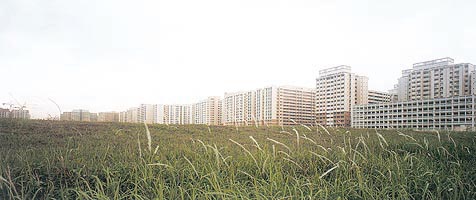
Plaza y jardín en el paisaje urbano
Square and garden in the urban landscape
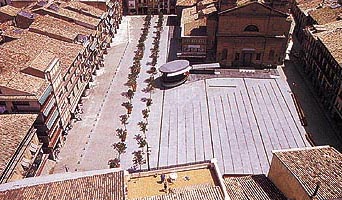
Alberto Mengual Muñoz

Plaza y jardín en el paisaje urbano Square and garden in the urban landscape |

Alberto Mengual Muñoz |
|
La ciudad tradicional se presenta como un conjunto edificado, compacto y separado de la naturaleza, donde el hombre ha creado sus propios espacios, su paisaje; paisaje que en contraposición a la naturaleza, acota y racionaliza en un afán de humanizar su entorno. La ciudad actual, con su crecimiento desmesurado, ha invadido la naturaleza circundante alterando la relación entre lo construido y lo no construido, diluyéndose y extendiéndose los límites de la ciudad en un entorno indefinido, donde la naturaleza ha sido forzada a abandonar su carácter intrínseco. Esta transformación del paisaje natural en paisaje artificial o al menos construido no ha supuesto la creación de lugares mejores. Como consecuencia de estas intervenciones se generan espacios libres por el simple cumplimiento de un estándar urbano, que por lo general se abandonan a su suerte sin un claro significado dentro del contexto de la ciudad. Por otro lado, la rapidez de desarrollo y la tecnología de nuestro mundo actual han producido una geografía en la que los lugares ya no tienen el mismo significado ni se perciben con las características con las que fueron creados. De una lectura pausada del espacio, hemos pasado a una lectura dinámica de todos los espacios, lo que ha supuesto la transformación de los valores que percibimos en ellos. Si consideramos que nuestra percepción de la ciudad en su concepción tradicional ha cambiado, no así cabe decirlo de los planteamientos urbanísticos, los cuales mantienen una concepción del espacio libre como vacío, que si bien sigue aumentando en cuantía métrica, no da respuesta a las nuevas necesidades del ser humano en su relación con el espacio. Estas necesidades sin embargo sí han sido captadas por los profesionales del consumo. Mientras que los espacios libres de la ciudad se vacían día a día reduciéndose cada vez mas su uso, los espacios similares creados en las grandes áreas comerciales y de ocio cuentan cada vez con mayor número de usuarios. La mayor agilidad en la acomodación fácil a los gustos de los ciudadanos les permite crear espacios de usar y tirar, espacios "Kleenex" que desaparecen cuando dejan de ser útiles al comercio al que sirven. Por ello, lejos de plantearnos los espacios libres de la ciudad como espacios creados para su servicio, ya sea para articular su trama urbana como para cumplir con un estándar urbano de calidad, y lejos también de plantear estos lugares como espacios dotacionales que bajo una visión bidimensional de la ciudad aparecen bajo manchas mas o menos intensas repartidas en toda su extensión, nos planteamos su valoración desde un punto de vista cualitativo, desde una visión ajena a esa estandarización que fuerza a la creación de espacios sin otro objetivo que el cumplimiento de normativas urbanísticas. Situados intramuros, estos espacios libres surgen como espacios con carácter propio, como escenarios donde el hombre adquiere su propio protagonismo en intimidad o en su relación con sus congéneres. La plaza, lugar de reunión por excelencia, de acontecimiento sociales y de participación, de encuentro y charla, de comunicación con los demás. El jardín, intimo, sensual, espacio de meditación, de percepción y encuentro con uno mismo. La plaza, cargada de atributos, juega un papel histórico, de memoria de acontecimientos pasados o para el futuro recuerdo. El jardín, utopía de una naturaleza creada por el hombre, responde a una necesidad de placer sensual, en contraste con una realidad biológica acomodada a un mundo distanciado de sus orígenes. El espacio adquiere aquí las dimensiones que el ser humano capta de la propia naturaleza y responde a sus reflexiones sobre como debía ser esta. En cualquier caso, ambos, como espacios abiertos diseñados, acomodados, se presentan como territorios donde cada persona establece sus referencias espaciales, temporales, abstractas, destilándose en ellos la esencia de la ciudad. Ambos dan respuesta a unas necesidades hoy por hoy banalizadas o mas bien reducidas por sistemas de consumo que dificultan las normales relaciones de cada individuo a través de estos lugares. La plaza deriva en vacío urbano articulador de tráficos de vehículos o intercambiador de medios de transporte. El jardín en reducto extraño donde la naturaleza pervive, vacío urbano refugio de enamorados. La tendencia cada vez mas creciente hacia espacios multifuncionales, o justificados en aras a una mayor rentabilidad social (¿comercial?) ha derivado hacia la creación de espacios libres privados de características acomodadas a intenciones ajenas a las necesidades que les dio origen. El espacio, pues, pasa a servir a intereses para los que no fue concebido. La plaza, en estos casos se presenta como un espacio envolvente de formas arbitrarias cuyo objeto es facilitar la mayor atención del individuo hacia el continuo escaparate y el jardín como una justificación ante las nuevas sensibilidades medioambientales. Aparentemente antagónicos, hoy vemos en ellos mas puntos en común que distanciamiento. Frente a un conglomerado de espacios cerrados o controlados, se presentan como espacios abiertos o verdaderamente libres, como negativo o positivo de otros usos claramente encontrados, y frente a un mundo dinámico y rápido, se presentan como espacios de circulación lenta, de sosiego, de parada. El descubrimiento de otras formas de relación surgidas a través de nuevos modos de comunicación, supone un nuevo entendimiento del espacio, donde cada usuario pasa a ser un elemento activo en su generación. A través de estas distintas percepciones, pasamos de recibir y adaptarnos a un espacio previamente creado, a generar nuestro propio espacio acomodado a nuestras pasiones, humores e intenciones en cada momento. Parece, por tanto, que el espacio virtual, en su indefinición, permite unas posibilidades "mas reales" que el propio espacio real. Si bien esto puede parecer un tópico, no cabe duda que con ello ha cambiado la mirada del hombre sobre las cosas, surgiendo diferentes pautas de lectura de la realidad. La transformación de las actividades humanas, de las formas de vida, de todo el contexto económico y social a través de un crecimiento espectacular, el cambio de percepción de lo social, lo público y lo colectivo, han supuesto a su vez una transformación de las relaciones del ser humano con el espacio que le rodea. ¿Cómo podríamos concretar estos entornos a los que se tiende o en los que se producen las relaciones en la actualidad?. Hoy mas que nunca se busca la interrelación entre espacios, la superposición o confluencia de funciones. Las nuevas relaciones entre arquitectura y paisaje, entre espacios cerrados y abiertos proponen nuevas formas de arquitectura donde no resulta necesario distinguir entre interior y exterior, donde los usos pueden acomodarse indistintamente estableciendo relaciones mucho mas directas y donde las fronteras o límites desaparecen diluyéndose y generando nuevos espacios de transición. La integración en el paisaje, ya sea natural o urbano, no puede ser solo volumétrica. Requiere de cierta permeabilidad no solo espacial, sino también funcional, de nuevas energías que llenen los "vacios" de la ciudad de contenidos, que transformen los simples espacios libres en espacios de acogimiento, adecuándolos o multiplicando sus usos. La condición de los espacios libres urbanos debe estar ligada a su reconsideración y reelaboración continua en el tiempo con la suficiente agilidad para adaptarla y adecuarla a las necesidades de cada momento. La plaza, el jardín, responden a una manifestación cultural propia del momento en que fueron creados, pero no por ello debemos olvidar su principal función en el contexto de la ciudad. Deben mantenerse vivos. |
The traditional city is a built whole, compact and separate from nature, where people have created their own spaces, their own landscape. This landscape contrasts with the natural one, enclosing and rationalising in an attempt to humanise its environment. The city of today, with its excessive growth, has invaded its natural surroundings and altered the relationship between built and unbuilt. The edges of the city have been extended and shade off into an undefined environment that has forced a loss of the intrinsic character of nature. This transformation of the natural landscape into an artificial or at least build landscape has not led to better places being created. This development creates open spaces purely in order to comply with planning standards. They are generally abandoned to their fate and have no clear meaning in the context of the city. From another point of view, the speed of development and technological advances in our present-day world have created a geography where places no longer have the same significance and are not viewed as possessing the features with which they were created. We have passed from an unhurried reading of space to a dynamic reading of all spaces. This has led to a transformation of the values we perceive in them. If we consider that our perception of the traditional concept of the city has changed, the same cannot be said of attitudes towards town planning, which continue to view open spaces as vacuums. Although the number of square metres continues to rise, they do not provide answers to the new needs of human beings in their relationship with space. These needs, however, have certainly been perceived by the purveyors of consumption. While the city’s open spaces grow steadily emptier and their use shrinks day by day, similar spaces created in large shopping and leisure centres gain an increasing number of users. Their greater adaptability and ease in accommodating the tastes of the public allows them to create throw-away spaces, ‘Kleenex’ spaces that disappear when they cease to be useful to the commerce they serve. Consequently, rather than thinking of the city’s open spaces as spaces created to serve it, whether to articulate the urban fabric or to comply with an urban quality standard, and rather than approaching these places as service spaces which, in a two-dimensional view of the city, appear in more or less concentrated patches distributed everywhere, we should consider valuing them from a qualitative point of view, one which is alien to the standardisation that obliges spaces to be created with the sole objective of complying with the planning regulations. The free spaces located ‘within the walls’ thus become spaces with their own character, stages where people are players in their own right, by themselves or in relation to their fellows. The square is the meeting place par excellence, the place for social events and taking part, for meeting and talking, for communicating with others. The garden is intimate, sensual, a place to meditate, perceive, to find oneself. The square has many qualities and plays a historical rôle as a memorial to past events or future memories. The garden is a utopian vision of nature created by man. It answers the need for sensual pleasure, in contrast to a biological reality that has adjusted to a world which has distanced itself from its origins. In the garden, space acquires the dimensions that human beings receive from nature itself and responds to their reflections on how nature should be. Whichever the case, both of them are designed, adapted open spaces. They are territories where each person establishes his or her own abstract spatial and temporal references, distilling the essence of the city in them. Both respond to needs that have become trivialised or, rather, diminished nowadays by consumption systems that raise obstacles to the normal relationships of each individual with and through these places. The square degenerates into an urban vacuum to articulate the traffic or a transport interchange. The garden is a strange redoubt where nature survives, an urban vacuum where lovers take refuge. The increasing trend towards spaces being multi-functional or justified on the grounds of greater social (commercial?) profit has led to the creation of private open spaces of a nature that fits objectives which are a far cry from the needs that originated them. Space thus turns to serving interests for which it was not conceived. The square then becomes an enveloping space with arbitrary shapes designed to focus the individual’s attention on the continuous shop window, while the garden is a sop to the new environmental sensibilities. Although they appear to be opposites, nowadays we see more points in common than separation between them. In comparison to a conglomerate of enclosed or controlled spaces they are open or truly free spaces, like the negative (or positive) of other clearly opposite uses. In contrast to a fast, dynamic world they are spaces for moving slowly, stopping, being peaceful. The discovery of other ways of relating that have developed out of new forms of communication brings a new understanding of space, one where each user takes an active part in generating it. Through these different perceptions we cease to receive and adapt ourselves to a previously created space and begin to generate our own space, adjusted to the passions, humours and intentions of our every moment. It therefore seems that virtual space, in its undefinedness, offers us possibilities that are "more real" than real space. Although this may seem a cliché, it has unquestionably changed the way people look at things and given rise to new criteria for interpreting reality. The transformation of human activities, of ways of living, of the entire social and economic context as a result of spectacular growth, the changing perceptions of what social, public or collective mean, have in turn transformed the relationships between human beings and the space that surrounds them. How should we define these surroundings we are tending towards or where relations are formed nowadays? Today, more than ever, what is sought is to interrelate spaces, with functions overlapping or converging. The new relations between architecture and landscape, between closed and open spaces, suggest new forms of architecture that do not need to make a distinction between interior and exterior, where uses can be fitted in without distinction, that set up much more direct relations where the frontiers or limits disappear, shading off into new transitional spaces. Integration into the landscape, whether natural or urban, cannot be solely a question of volumes. It requires a certain permeability, not only spatial but also functional, new energies that fill the "vacuums" of the city with content, that transform merely open spaces into welcoming spaces, adapting them or multiplying their uses. Their nature as urban free spaces must be connected with continually reconsidering and reworking them over time, flexibly enough to adapt and accommodate them to the needs of each moment. The square and the garden are a cultural manifestation of the moment when they were created, but this should not make us forget their main function in the context of the city. They must remain alive. |
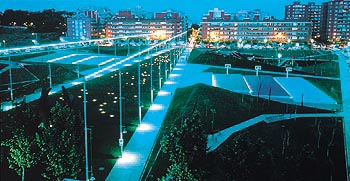
|
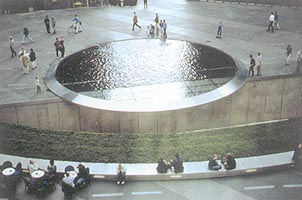
|
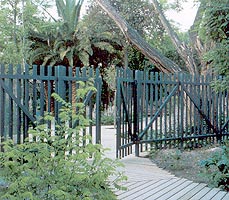
|
|
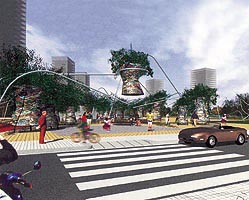
|
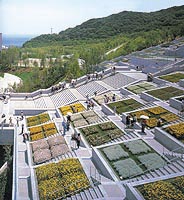
|
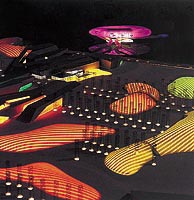
|